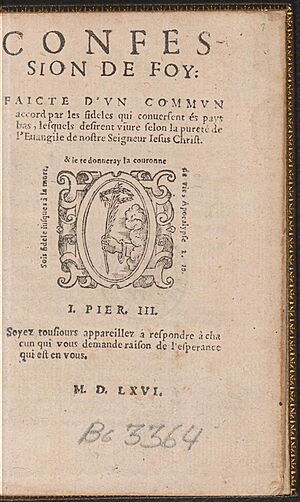Belgic Confession facts for kids
The Belgic Confession is a very important document that explains the beliefs of many Reformed churches. Think of it as a statement of faith that these churches use. It is one of the Three Forms of Unity, which are official guides for the Dutch Reformed Church. The main person who wrote the Belgic Confession was Guido de Brès. He was a preacher in the Netherlands and sadly died for his faith in 1567 during a time of big changes called the Dutch Reformation. Guido de Brès first wrote this confession in 1559.
Contents
What Does "Belgic" Mean?
The name Belgic Confession comes from a Latin name, Confessio Belgica. The word Belgica used to mean all of the Low Countries. Today, this area is split into two countries: the Netherlands and Belgium. So, the name simply refers to the region where it was created.
Who Wrote It and How It Changed
Guido de Brès was a Reformed Protestant. When he first wrote the document, he was inspired by another similar text called the Gallic Confession. He shared his early draft with friends like Hadrian à Saravia and Franciscus Junius. Franciscus Junius made some changes and sent copies to other churches for their approval.
In 1562, the confession was given to Philip II of Spain. The hope was that he would allow Protestants in the Low Countries to practice their faith freely. Later, in 1566, the text was updated at a meeting in Antwerp. It was then officially accepted by national church meetings over the next few decades.
The Belgic Confession became a key document during a time of disagreement known as the Arminian controversy. Some people, including Jacob Arminius, had different ideas about certain beliefs. However, Arminius himself said he still supported the Belgic Confession until he passed away in 1609. The text was updated again at a very important meeting called the Synod of Dort in 1618-1619. After this, it became one of the main statements of belief that all leaders and members of Reformed churches had to agree to. This final version was written in French.
The first French versions of the confession were printed in 1561 and 1562. In 1580, a church meeting in Antwerp decided that every new minister should sign a copy of the updated text. This copy is still seen as the official document in the Belgic churches.
The confession was translated into Latin in 1581. Later, another Latin translation was made for the Synod of Dort in 1618. This second Latin version was then used to create the English translation that is still used today in the Reformed (Dutch) Church in America. It was even translated into Greek in the 1600s!
What It Says
The Belgic Confession has 37 different articles, or sections. These articles talk about many important beliefs:
- God: Articles 1–2 and 8–13 explain who God is.
- The Bible: Articles 3–7 discuss the importance of the Bible.
- People: Article 14 talks about humanity.
- Sin: Article 15 explains sin.
- Jesus Christ: Articles 18–21 focus on Jesus.
- Salvation: Articles 16–17 and 22–26 explain how people are saved.
- The Church: Articles 27–36 describe the Church.
- The End Times: Article 37 talks about the future.

See also
- Marks of the Church (Protestantism)


